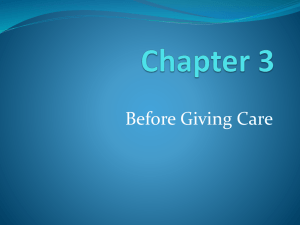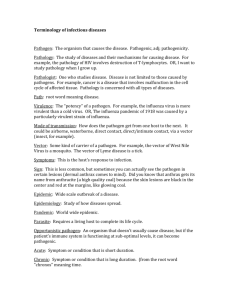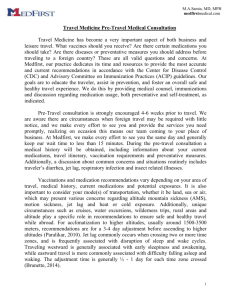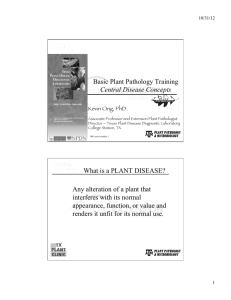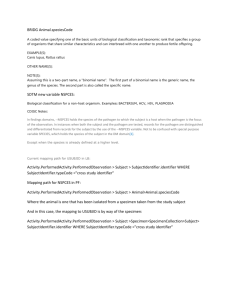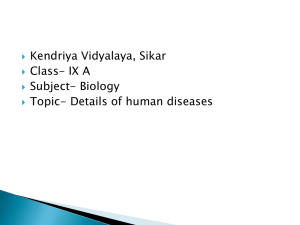Supplement 1. - Springer Static Content Server
advertisement
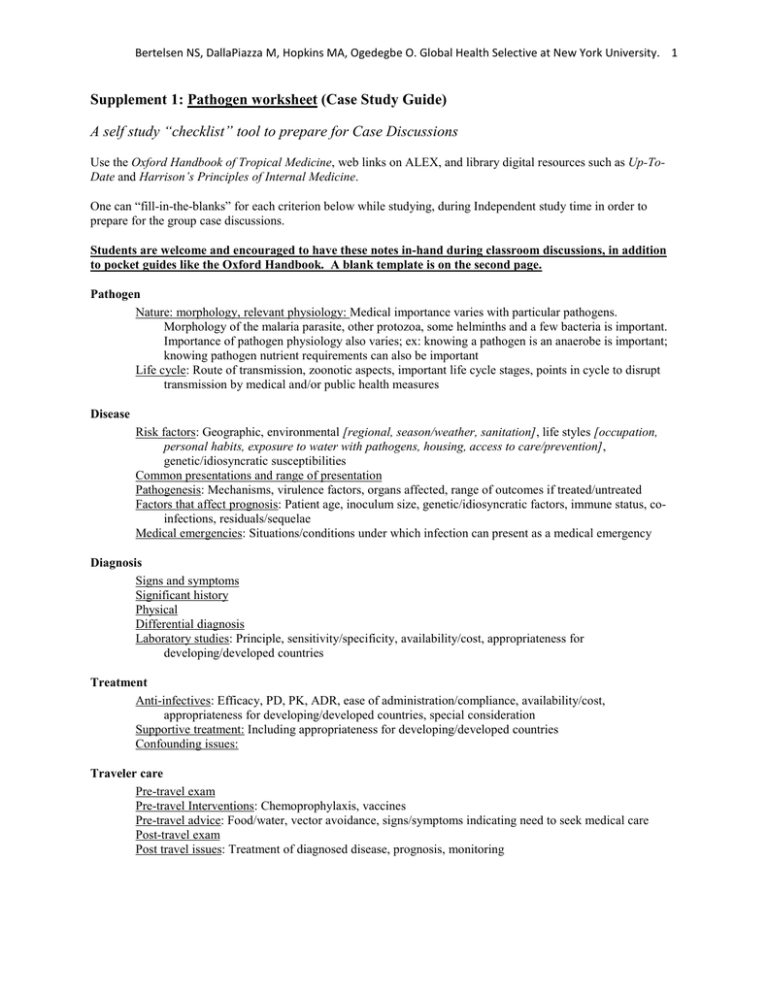
Bertelsen NS, DallaPiazza M, Hopkins MA, Ogedegbe O. Global Health Selective at New York University. 1 Supplement 1: Pathogen worksheet (Case Study Guide) A self study “checklist” tool to prepare for Case Discussions Use the Oxford Handbook of Tropical Medicine, web links on ALEX, and library digital resources such as Up-ToDate and Harrison’s Principles of Internal Medicine. One can “fill-in-the-blanks” for each criterion below while studying, during Independent study time in order to prepare for the group case discussions. Students are welcome and encouraged to have these notes in-hand during classroom discussions, in addition to pocket guides like the Oxford Handbook. A blank template is on the second page. Pathogen Nature: morphology, relevant physiology: Medical importance varies with particular pathogens. Morphology of the malaria parasite, other protozoa, some helminths and a few bacteria is important. Importance of pathogen physiology also varies; ex: knowing a pathogen is an anaerobe is important; knowing pathogen nutrient requirements can also be important Life cycle: Route of transmission, zoonotic aspects, important life cycle stages, points in cycle to disrupt transmission by medical and/or public health measures Disease Risk factors: Geographic, environmental [regional, season/weather, sanitation], life styles [occupation, personal habits, exposure to water with pathogens, housing, access to care/prevention], genetic/idiosyncratic susceptibilities Common presentations and range of presentation Pathogenesis: Mechanisms, virulence factors, organs affected, range of outcomes if treated/untreated Factors that affect prognosis: Patient age, inoculum size, genetic/idiosyncratic factors, immune status, coinfections, residuals/sequelae Medical emergencies: Situations/conditions under which infection can present as a medical emergency Diagnosis Signs and symptoms Significant history Physical Differential diagnosis Laboratory studies: Principle, sensitivity/specificity, availability/cost, appropriateness for developing/developed countries Treatment Anti-infectives: Efficacy, PD, PK, ADR, ease of administration/compliance, availability/cost, appropriateness for developing/developed countries, special consideration Supportive treatment: Including appropriateness for developing/developed countries Confounding issues: Traveler care Pre-travel exam Pre-travel Interventions: Chemoprophylaxis, vaccines Pre-travel advice: Food/water, vector avoidance, signs/symptoms indicating need to seek medical care Post-travel exam Post travel issues: Treatment of diagnosed disease, prognosis, monitoring Bertelsen NS, DallaPiazza M, Hopkins MA, Ogedegbe O. Global Health Selective at New York University. 2 CASE STUDY GUIDE: DISEASE: Pathogen Nature: Life cycle: Vector: Disease Risk factors: Common presentations and range of presentation: Pathogenesis: Factors that affect prognosis: Medical emergencies: Diagnosis Signs and symptoms: Significant history: Physical: Differential: Laboratory studies: Treatment Anti-infectives: Supportive treatment: Confounding issues: Traveler care Pre-travel exam Pre-travel Interventions: Pre-travel advice: Post-travel exam: Post travel issues: Bertelsen NS, DallaPiazza M, Hopkins MA, Ogedegbe O. Global Health Selective at New York University. 3 Supplement 2: Student assessment tool for clinical skills simulations Student: Simulation: Faculty: Skill Objective Information gathering Posed one question at a time Used open-ended questions Repeated information for clarity Elicited pertinent symptomatology and history Relationship development Improved rapport with non-verbal behavior (eye contact, posture) Responded appropriately to patient’s emotions Used easily-understood words Practice-based learning Education and counseling Cultural sensitivity • • • • Professionalism • • • • • Recognized and adapted to resourcelimited settings Created cost-effective, evidence-based, patient-centered treatment plans Checked for patient’s understanding and assessed health literacy Explained clearly Used the Teach-Back method Addressed patient’s concerns and questions appropriately Employed the BATHE technique for clinical empathy Explored cultural and social determinants of heath Did not dismiss or judge patient’s belief systems Addressed barriers to communication and to healthy behaviors Used respectful tone Was sensitive/responsive to patients needs Handled own emotions appropriately Worked well within the team Demonstrated understanding of ethical issues related to patient needs Not done Partially done Well done Comments Bertelsen NS, DallaPiazza M, Hopkins MA, Ogedegbe O. Global Health Selective at New York University. 4 Supplement 3: Student assessment tool for case discussions Student: Case: Faculty: Excellent Preparation: Demonstrates knowledge of: Portal of entry Risk factors Pathogenesis Natural history Information gathering: Elicits salient information from case history Makes reasonable interpretations Suggests when additional information is needed Management: Evaluates disease severity and intervention urgency Knows, understands, and is able to discuss therapy options Develops reasonable management plan Predicts probable outcomes Professionalism: Respectful Works well within the group Offers teaching points based on student’s own expertise Good Average Below Average Comments

